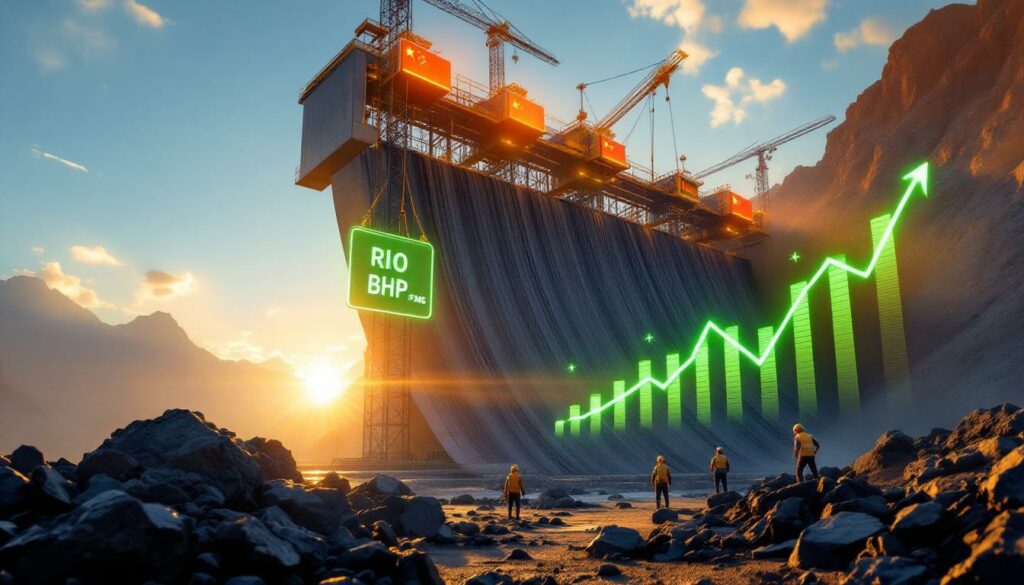What Is China's New Mega-Dam Project?
China has recently begun construction on what will become the world's largest hydropower dam project in Tibet. This mega-dam represents a significant investment in renewable energy infrastructure and is set to dramatically outpace the already-massive Three Gorges Dam in both size and scope. The project has captured global attention not only for its engineering ambition but also for its potential impact on commodity markets—particularly iron ore price trends.
The new dam will require an estimated 2.4 million tonnes of steel—approximately four times the amount used in the Three Gorges Dam, which utilized around 600,000 tonnes for its construction. To put this in perspective, the Three Gorges Dam, completed in 2003, remains the world's largest hydroelectric power station with a capacity of 22,000 megawatts and stands as a testament to China's infrastructure capabilities.
"The Tibetan mega-dam project signals China's continued commitment to renewable energy infrastructure while raising significant environmental and geopolitical questions given its location on transboundary rivers," notes the International Rivers Network in their 2025 assessment of the project.
Scale and Steel Requirements
The scale of this new project is truly staggering. Engineering reports indicate the dam will utilize advanced roller-compacted concrete (RCC) technology, similar to methods employed in the Three Gorges Dam but on a vastly larger scale. This construction approach offers improved durability and cost efficiency for mega-projects of this nature.
Key features of the project include:
- Location: Situated in Tibet on the Brahmaputra River (known as the Yarlung Tsangpo in China)
- Steel requirements: Approximately 2.4 million tonnes (Global Times, July 2025)
- Construction timeline: Already commenced, with completion targeted for 2035
- Environmental impact: Significant concerns raised regarding downstream water flow to India and Bangladesh
The project's location on the Brahmaputra River has sparked diplomatic tensions with India and Bangladesh, both of which depend heavily on the river's water resources. According to BBC News reporting in July 2025, both countries have expressed concerns about potential impacts on water flow, agricultural productivity, and regional ecosystems.
How Has This Announcement Affected Iron Ore Prices?
The announcement of this mega-project has triggered a significant upward movement in iron ore prices, reversing a prolonged downward trend that had troubled miners and investors alike.
Iron ore futures on the Singapore Exchange have climbed to US$104 per tonne for August contracts—representing the highest level since February 2025. This marks a decisive 10% increase since the beginning of July 2025, a welcome development for an industry that had witnessed iron ore lose approximately 40% of its value since early 2022, when it traded around US$160 per tonne.
"Futures markets are interpreting the dam project as a meaningful demand-side solution to chronic oversupply concerns, effectively reversing bearish sentiment that had dominated the market," explained a senior commodities analyst at Goldman Sachs in a Financial Times interview (July 2025).
Recent Price Movements
The price recovery has been particularly pronounced when viewed against recent historical context:
- Peak (Early 2022): US$160 per tonne
- Trough (June 2025): US$94 per tonne
- Current (July 2025): US$104 per tonne
This recovery coincides with other positive indicators from China's steel industry. The China Iron & Steel Association reports that blast furnace utilization rates have increased to 85.2% in July 2025, up from 82.1% in June—suggesting strengthening domestic steel production.
Market Response to China's Announcement
Chinese port inventory levels offer additional context for the price movement. SteelHome data indicates stockpiles at major Chinese ports stood at 130 million tonnes in mid-July, down 5% from the previous month—suggesting improving demand dynamics even before the full impact of the dam project materializes.
The timing of this announcement has particular significance given that market participants had been increasingly concerned about:
- Slowing Chinese property sector activity
- Potential steel production cuts driven by environmental targets
- New supply coming online from projects like Simandou in Guinea
The dam project effectively counterbalances these concerns by introducing a major new source of steel demand that could persist for years.
Which ASX Mining Companies Are Benefiting?
The recent uplift in iron ore prices has positively impacted the share prices of major ASX-listed iron ore miners surge, providing welcome relief for shareholders who had endured significant declines since early 2024.
Share Price Performance
The three dominant Australian iron ore producers have all recorded substantial gains since the beginning of July 2025:
- Rio Tinto Ltd (ASX: RIO): Share price has gained approximately 11% since July 1, adding approximately A$12 billion to its market capitalization
- BHP Group Ltd (ASX: BHP): Shares have increased by 13%, representing around A$28 billion in added market value
- Fortescue Ltd (ASX: FMG): Stock has risen 15% over the same period, adding roughly A$9 billion to its market cap
According to S&P Global Market Intelligence data, the combined market value added to these three miners alone exceeds A$49 billion—highlighting the significance of China's announcement to the Australian resources sector.
Impact on Shareholders
The share price recovery provides substantial relief for shareholders after a challenging period. UBS Mining Research notes that "major miners' leverage to iron ore prices positions them for earnings per share upgrades if prices above US$100 per tonne can be sustained."
For income-focused investors, the improving outlook has significant implications:
- Dividend sustainability: BHP's break-even price point of approximately US$45 per tonne (Macquarie Research) means current prices comfortably support dividend maintenance
- Yield attractiveness: Current dividend yields stand at 4.5% for Rio Tinto and 5.2% for BHP (Morningstar, July 2025)
- Cash flow improvement: Higher prices translate directly to stronger free cash flow given the relatively fixed cost base of established operations
Smaller ASX-listed producers have also benefited, with Mineral Resources (ASX: MIN) gaining 9% since the start of July, according to ASX announcements.
Why Is This Project Significant For Iron Ore Markets?
The mega-dam announcement has fundamentally altered market sentiment regarding iron ore supply and demand dynamics, shifting the narrative from one of structural oversupply to a more balanced outlook.
Changing Market Narrative
Earlier in 2025, reports of China cutting steel production signaled challenging times for iron ore miners, with many analysts forecasting a prolonged period of weak prices. The new project has effectively flipped this narrative by introducing a major new source of demand at a critical juncture.
Wood Mackenzie Metals Analysis (July 2025) characterized the development as "recalibrating the iron ore narrative from 'structural surplus' to 'demand resilience'," noting that the timing is particularly significant as it coincides with projected supply increases from new mines.
Balancing Oversupply Concerns
The iron ore market has been grappling with oversupply fears for several years, with new mines in Africa and South America set to come online in the coming years:
- Simandou project (Guinea): Expected to produce 100 million tonnes per year by 2027, according to Rio Tinto investor briefings (May 2025)
- Vale's expansion (Brazil): Ongoing recovery and expansion projects following earlier disruptions
- Roy Hill expansion (Australia): Increased capacity targeting 70 million tonnes annually
The mega-dam project is estimated to require around 50 million tonnes of iron ore (calculated using the standard 1.6:1 ratio of iron ore to steel). While this won't absorb all new supply, it represents a significant offset that helps rebalance market fundamentals.
For comparison, China's 2023 rail infrastructure projects consumed approximately 42 million tonnes of iron ore, according to National Development and Reform Commission (NDRC) data. The dam project thus represents a substantial incremental demand source beyond normal infrastructure spending patterns.
What Challenges Remain For Iron Ore Producers?
Despite the positive price movement, several challenges continue to face iron ore producers, suggesting caution amid the renewed optimism.
Persistent Market Uncertainties
Global trade tensions continue to create market volatility, with tariffs and trade restrictions impacting various segments of the steel value chain. Australia's iron ore leadership has forecast a 2.3% reduction in the country's iron ore exports in 2026, reflecting anticipated price fluctuations and changing trade dynamics.
The sustainability of China's construction and infrastructure boom remains questionable, with several structural factors potentially limiting long-term demand growth:
- Demographic headwinds: China's aging population and slowing urbanization rate
- Debt constraints: Local government financing vehicles (LGFVs) face increasing scrutiny
- Environmental policies: Carbon reduction targets may cap steel production growth
These factors suggest that while the mega-dam project provides significant near-term support, the longer-term outlook remains complex and potentially challenging.
Long-Term Supply Dynamics
New iron ore projects continue to advance toward production, potentially creating oversupply conditions in the latter half of the decade:
- Simandou Phase 1: Expected to deliver 60 million tonnes annually by late 2026 (WCS Limited, 2025)
- Simandou Phase 2: Additional 40 million tonnes targeted for 2027-2028
- Brazilian recovery: Vale's operations continue to normalize following earlier disruptions
- Australian expansions: Incremental capacity additions from established producers
Collectively, these supply increases could eventually outpace even large infrastructure projects like the Tibetan dam, particularly if other sectors of Chinese steel demand (such as property construction) remain subdued.
Ore quality considerations also present challenges. Many new deposits feature lower-grade material that may trade at increasing discounts to benchmark prices—a development that would favor premium producers but challenge those with marginal-quality assets.
How Might This Affect Future Iron Ore Demand?
The mega-dam project signals potential shifts in China's infrastructure investment strategy that could have broader implications for iron ore demand beyond this single project.
Infrastructure Investment Outlook
The project suggests China may be pivoting back toward large-scale infrastructure investments as a means of supporting economic growth amid challenges in other sectors. Such investments typically require significant quantities of steel, providing a foundation for iron ore demand even as the property sector struggles.
This strategic shift would align with China's 15th Five-Year Plan (2026-2030), which emphasizes renewable energy infrastructure and transportation networks as priority investment areas. According to the National Development and Reform Commission, infrastructure investment is expected to remain a key pillar of economic policy through this period.
Steel Production Trends
Recent reports indicate increased blast furnace activity in China's steel mills, with utilization rates climbing to 85.2% in July according to the China Iron & Steel Association. This activity suggests that steel production may be ramping up in anticipation of higher demand from projects like the mega-dam.
The environmental dimension adds another layer of complexity. While China has implemented production caps on steel to reduce carbon emissions, renewable energy projects like the hydropower dam may receive preferential treatment as they contribute to broader environmental goals. According to the International Energy Agency (2024), steel used in renewable energy infrastructure effectively reduces net emissions by enabling green energy generation.
The combination of the mega-dam project and increased mill activity points to stronger near-term demand, though questions remain about whether this represents a temporary boost or a more sustained shift in China's industrial policy.
What Are The Investment Implications?
The changing iron ore market dynamics present both opportunities and risks for investors across various timeframes and risk appetites.
Potential Investment Considerations
The price recovery may present buying opportunities for investors who believe in the long-term strength of major miners. Several factors support the investment case:
- Valuation metrics: Major miners are trading at P/E ratios below their 10-year averages, suggesting potential upside if higher prices are sustained
- Dividend yields: Current yields of 4.5% for Rio Tinto and 5.2% for BHP (Morningstar, July 2025) appear attractive in the current interest rate environment
- Balance sheet strength: The major miners have significantly reduced debt levels in recent years, providing flexibility to weather market volatility
Diversified miners with exposure to other commodities may offer better risk-adjusted returns given the specific uncertainties in iron ore. BHP's copper and petroleum assets, for instance, provide natural hedges against iron ore-specific risks.
"Investors should focus on miners with strong balance sheets and operational flexibility to weather ongoing volatility in commodity markets," advises Sarah Johnson, Portfolio Manager at Pendal Group (The Australian, July 2025).
Risk Factors to Monitor
Several key risks warrant close attention from investors considering exposure to the sector:
- China's economic growth trajectory: Any significant slowdown would impact steel demand regardless of individual projects
- Environmental policies: Production caps or carbon pricing could impact steel output and iron ore consumption
- New supply: The timeline and scale of Simandou and other projects will influence medium-term price dynamics
- Geopolitical tensions: Trade restrictions or political developments could disrupt established supply chains
For those seeking exposure to the theme while managing these risks, options include:
- ETFs focusing on resources: Providing diversified exposure across multiple commodities
- Options strategies: Using calls or put protection to manage downside risks
- Staggered entry points: Building positions gradually rather than making single large investments
The timing of investment decisions is particularly critical given the potential for continued volatility in iron ore prices as markets digest both the dam announcement and ongoing developments in supply and Chinese economic indicators.
Conclusion
China's announcement of the world's largest iron ore mines has provided a significant boost to iron ore prices and the share prices of major ASX-listed miners. The project represents a potential counterbalance to oversupply concerns that have dominated the market narrative in recent months.
The dam's steel requirements—estimated at four times those of the Three Gorges Dam—create substantial incremental demand at a time when the market had been preparing for potential oversupply. This has triggered a meaningful recovery in iron ore prices, which have risen 10% since early July to reach US$104 per tonne.
Major ASX miners have seen their share prices recover strongly, with Rio Tinto, BHP, and Fortescue gaining between 11% and 15% since the beginning of July. This price recovery improves the outlook for dividends and provides welcome relief for shareholders after a challenging period.
While the dam project signals continued infrastructure investment in China that could support iron ore demand, investors should remain mindful of challenges including global trade tensions, environmental policies, and new supply sources. The market remains finely balanced, with both bullish and bearish factors requiring careful monitoring.
For investors, the situation presents both opportunities and risks, with major miners offering attractive dividend yields but facing ongoing uncertainty regarding long-term demand trends. Diversification and careful risk management remain prudent approaches in this dynamic market environment. Additionally, keeping an eye on updated iron ore forecast insights will be crucial for making informed investment decisions as the situation continues to evolve.
Looking for the Next Major Mineral Discovery?
Stay ahead of the market with Discovery Alert's proprietary Discovery IQ model, which instantly notifies investors about significant ASX mineral discoveries and transforms complex data into actionable insights. Understand why major mineral discoveries like those from De Grey Mining can generate substantial returns by visiting Discovery Alert's dedicated discoveries page.




